 ellipse
parameters of a galaxy, thus improving the photometry.
ellipse
parameters of a galaxy, thus improving the photometry.
The basic ellipse fitting algorithm is described in Jarrett et al. 2000.
The following figures demonstrate an improved method
by which to derive the 3- ellipse
parameters of a galaxy, thus improving the photometry.
ellipse
parameters of a galaxy, thus improving the photometry.
Neighboring stars both confuse the desired isophote (3
 in this case)
and systematically bump up the flux of a galaxy. The nominal GALWORKS
solution to this dilemma is to mask all of the stars detected in the pipeline,
derive the ellipse parameters from the chopped-up image, and recover the lost
flux using isophotal substitution (i.e., assume symmetry and use the ellipse
parameters to build a ellipsoid model of the galaxy).
in this case)
and systematically bump up the flux of a galaxy. The nominal GALWORKS
solution to this dilemma is to mask all of the stars detected in the pipeline,
derive the ellipse parameters from the chopped-up image, and recover the lost
flux using isophotal substitution (i.e., assume symmetry and use the ellipse
parameters to build a ellipsoid model of the galaxy).
The modifications are mostly subtle, but with one significant difference. Instead of masking the stars outright, the new method subtracts the stars. Before this subtraction can occur, however, the underlying galaxy itself must be subtracted. Hence, the method is to employ an iterative loop that searches for the ellipsoid model of the galaxy with star subtraction.
 isophote, the most reliable first guess is
arrived at by using the inner 8´´ radius of the galaxy. Here we
compute the axis ratio and position angle by computing the optimal second
moment ratio (similar to what is
already being used to derive the PSF elongation). The solution will be biased
towards a more circular axis ratio, due to the round PSF, but the axis ratio
will be close to the correct answer. Keep in mind this is only a crude first
guess.
isophote, the most reliable first guess is
arrived at by using the inner 8´´ radius of the galaxy. Here we
compute the axis ratio and position angle by computing the optimal second
moment ratio (similar to what is
already being used to derive the PSF elongation). The solution will be biased
towards a more circular axis ratio, due to the round PSF, but the axis ratio
will be close to the correct answer. Keep in mind this is only a crude first
guess.
 )(1/
)(1/ )]
)]
which nicely models the PSF. Here we need to know the "shape" or
( *
*  )
and
)
and  . The "shape" comes from
SEEMAN (and GALWORKS),
computed for every Atlas Image (hence, tracking the PSF seeing).
The parameter
. The "shape" comes from
SEEMAN (and GALWORKS),
computed for every Atlas Image (hence, tracking the PSF seeing).
The parameter  also comes from
GALWORKS, but for only the scan average.
also comes from
GALWORKS, but for only the scan average.
Here, we centroid the star to get the correct position. We use the peak flux of the source, f0, corresponding to the peak of the galaxy-subtracted image.
The subtraction is not fully completed, however. We use isophotal substitution (i.e., using the symmetric shape of the object; see step 4 below) as an additional component which is averaged with the resultant residual, described above.
 isophote of the star-subtracted image. We use the same method employed in
GALWORKS.
isophote of the star-subtracted image. We use the same method employed in
GALWORKS.
With the ellipse parameters optimally derived, we then can perform isophotal substitution to eliminate the stars from the photometry. Note: we could use the star-subtracted image; however, there will always be residual flux from the star, since subtraction is not perfect, particularly for the central pixels of the star. Isophotal substitution is probably the most robust method for eliminating stars; however, note that this only works if the galaxy is symmetric (which is usually the case).
Case 1: galaxy at (ra, dec) = (241.9399, -59.92483), or (glon, glat) = (325.3076, -5.8810), with Ks=11 mag. The stellar density is high, at 4.16 (log no. sources deg-2 brighter than Ks=14 mag). Figure 1 shows the Ks-band image, 101´´ × 101´´ field.
Figure 2 shows the galaxy subtracted using a symmetric ellipsoid model. The ellipse parameters are derived (using second moment): axis ratio = 0.778, p.a. = 160.0. Using the old method, masking stars, we obtain what is shown in Figure 3. Using the new method, locating and subtracting stars, we obtain what is shown in Figure 4.
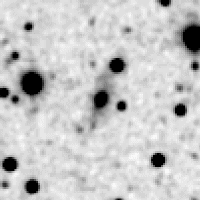 |
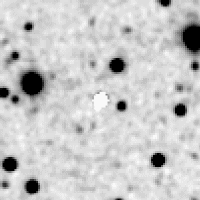 |
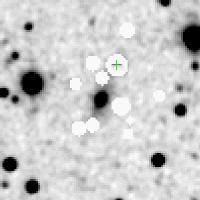 |
 |
| Figure 1 | Figure 2 | Figure 3 | Figure 4 |
Using the old GALWORKS method, we derive the new ellipse parameters axis ratio = 0.520 and p.a. = 160.0. Figure 5 shows the "raw" isophote, and Figure 6 shows the solution. Using the new method, we obtain axis ratio = 0.360 and p.a. = 165.0. Figure 7 shows the "raw" isophote, and Figure 8 shows the solution.
 |
 |
 |
 |
| Figure 5 | Figure 6 | Figure 7 | Figure 8 |
Next, we eliminate stars from original image using isophotal substitution. Figure 9 shows the results of the old method, while Figure 10 shows the results of the new method. Steps 2-4 are repeated using the new method (note that the images and solutions shown above are for the second iteration). With the new method we arrive at a final solution that is closer to "truth" than with the nominal, old method.
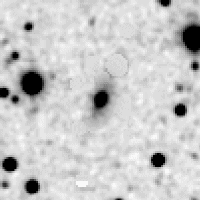 |
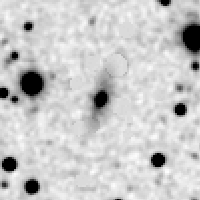 |
| Figure 9 | Figure 10 |
Case 2: galaxy at (ra, dec) = (241.82357, -60.68036), or (glon, glat) = (324.7513, -6.3989), with Ks=10.8 mag. The stellar density is 4.1. Figure 11 shows the Ks-band image, 101´´ × 101´´ field.
Figure 12 shows the galaxy subtracted using a symmetric ellipsoid model. The ellipse parameters are derived (using second moment): axis ratio = 0.7650, p.a. = 94.0. Using the old method, masking stars, we obtain what is shown in Figure 13. Using the new method, locating and subtracting stars, we obtain what is shown in Figure 14.
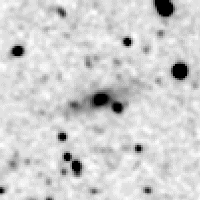 |
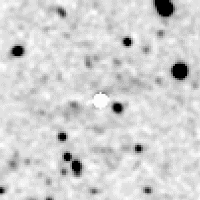 |
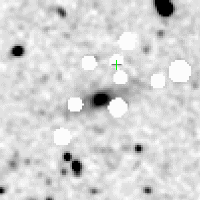 |
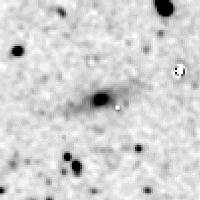 |
| Figure 11 | Figure 12 | Figure 13 | Figure 14 |
Using the old GALWORKS method, we derive the new ellipse parameters axis ratio = 0.340, p.a. = 105.0. Figure 15 shows the "raw" isophote, and Figure 16 shows the solution. Using the new method, we obtain axis ratio = 0.360, p.a. = 108.0. Figure 17 shows the "raw" isophote, and Figure 18 shows the solution.
 |
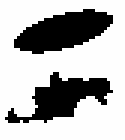 |
 |
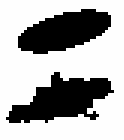 |
| Figure 15 | Figure 16 | Figure 17 | Figure 18 |
Next, we eliminate stars from original image using isophotal substitution. Figure 19 shows the results of the old method, while Figure 20 shows the results of the new method. Repeat steps 2-4 for the new method, etc.
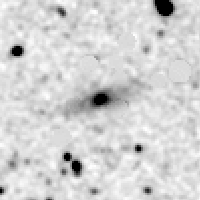 |
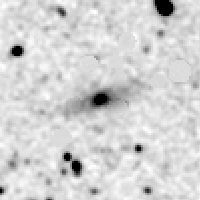 |
| Figure 19 | Figure 20 |
Case 3: face-on late-type galaxy at (ra,dec) = (284.901672, 19.427221), or (glon, glat) = (51.2129, 6.9933), with Ks=10.3 mag. The stellar density is 3.85. (This is perhaps the "worst-case scenario.") Figure 21 shows the Ks-band image, 101´´ × 101´´ field.
Figure 22 shows the galaxy subtracted using a symmetric ellipsoid model. The ellipse parameters are derived (using second moment): axis ratio = 0.9843, p.a. = 6.0. Using the old method, masking stars, we obtain what is shown in Figure 23. Using the new method, locating and subtracting stars, we obtain what is shown in Figure 24.
 |
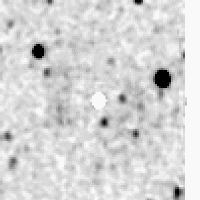 |
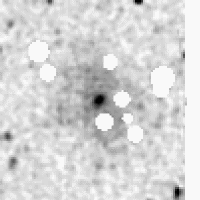 |
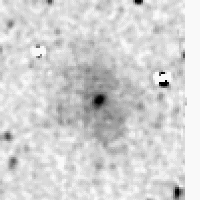 |
| Figure 21 | Figure 22 | Figure 23 | Figure 24 |
Using the old GALWORKS method, we derive the new ellipse parameters, axis ratio = 0.480, p.a. = 10.0. Figure 25 shows the "raw" isophote, and Figure 26 shows the solution. Using the new method, we obtain axis ratio = 0.540, p.a. = 10.0. Figure 27 shows the "raw" isophote, and Figure 28 shows the solution.
 |
 |
 |
 |
| Figure 25 | Figure 26 | Figure 27 | Figure 28 |
Next, we eliminate stars from original image using isophotal substitution. Figure 29 shows the results of the old method, while Figure 30 shows the results of the new method. Repeat steps 2-4 for the new method, etc.
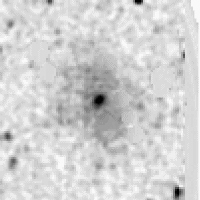 |
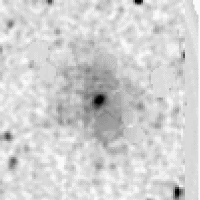 |
| Figure 29 | Figure 30 |
Finally, for small radii, we adjust the axis ratio such that the minimum semi-minor axis is 3´´. This modification is needed to counteract the circularizing effects of the PSF. The half-light "effective" aperture and Kron aperture are particularly affected by this modification, since they are allowed to shrink to radii near the PSF.
An example of a dynamically adjusted axis ratio is shown in Figure 31. The nominal axis ratio is 0.4, and the position angle is -45°. Note the increasingly circular aperture, as the radius approaches the size of the PSF.
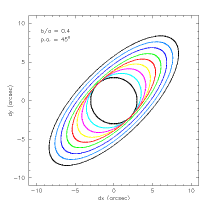 |
| Figure 31 |
[Last Updated: 2002 Jul 15; by T. Jarrett]